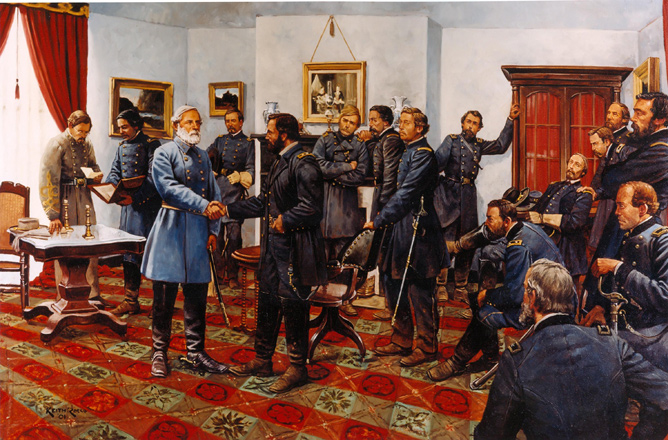
Elizabeth Bacon Custer, a significant chronicler of the West and the wife of George Armstrong Custer, was born in Monroe, Michigan on April 8, 1842.
Elizabeth Custer is best known today for her decades-long effort to celebrate her husband’s life and exonerate him for the massacre of the Seventh Cavalry at Little Bighorn in 1876. She was more than her husband’s apologist, however, and today her writings provide a rare female perspective on military life in the West of the mid-19th century.
Talented, intelligent, and beautiful, Elizabeth Custer graduated as valedictorian from the Young Ladies’ Seminary and Collegiate Institute in Monroe, Michigan. Not long after, she met Captain George Custer. After Custer’s bravery in several Civil War battles made him a national hero, Elizabeth’s father accepted Custer as a fit suitor for his daughter’s hand, and the couple married in 1864.
After the war, George Custer remained in the military, taking his young wife along on his many assignments around the nation. Long interested in writing, Elizabeth found that her life as an army wife provided her with excellent material.
For the rest of the story, see This Day In History : the Old West, History Channel.
For further reading, see :
Elizabeth Bacon Custer and the making of a myth / Shirley A. Leckie. Norman : University of Oklahoma Press, c1993. Also available in electronic format.
Tenting on the plains, or, General Custer in Kansas and Texas / by Elizabeth Bacon Custer ; with an introduction by Jane R Stewart ; foreword by Shirley A. Leckie. Norman : University of Oklahoma Press, 1994. First published in 1895 by Harper & brothers. Also available in electronic format.
David and William Birney — sons of the Bay City abolitionist — were major generals, recruiting and leading colored troops. And James G. Birney IV, grandson, enlisted in Bay City and rode with Gen. Custer in the Michigan Cavalry Brigade that stopped the rebel cavalry under Gen. J.E.B. Stuart and helped the North win the crucial Battle of Gettysburg.
On April 8, 1865, Gen. William Birney and his black troops trapped the remnants of Robert E. Lee’s Army of Northern Virginia as they neared Appomattox. Because he was halted and relieved of duty by Maj. Gen. E.O.C. Ord, Birney was denied the honor of capturing Lee and ending the war that day. Instead, Lee and his men were allowed to escape and fight another day. After another futile rebel attack costing about 600 lives, Lee finally was forced to surrender on April 9.
Source : Dave Rogers, “Black Diamonds: Talk Eyes Area Blacks in Civil War, More History Notables“, MyBayCity.com, February 20, 2015.
On April 8, 1871, Grand Ledge incorporated and immediately created a plan to make itself a resort destination. The resort business began after John Burtch launched a steamer in the Grand River for the purpose of taking passengers to the city’s Grand Island. In 1886, J. Scott Mudge bought the Grand Ledge resort and built a roller coaster, which is believed to be the first roller coaster in Michigan. By the time Mudge was finished, Grand Ledge was the second most popular resort town in Michigan, behind Petoskey.
Source: Michigan Every Day
Seven Islands Resort entry courtesy of the Grand Ledge Historical Society.
Student exchange program pioneer Rachel J. Andresen was born April 8, 1907 in Deerfield, Michigan. At the age of 16 she graduated at the top of her class and went on to receive her Bachelor of Fine Arts degree in Music from the Detroit Conservatory of Music. After marrying Henry Rose and having three children, she began teaching piano classes in order to help supplement the family’s income at the height of the Great Depression. After the death of her husband in 1934, she went back to school to obtain a master’s degree in social work.
Shortly after, she began to work at the YMCA in Detroit. Andresen eventually bought a large farmhouse with 82 acres of land near South Lyon, Michigan. She transformed the property into a summer camp and a year-round hostel for international travelers. She called the property Pinebrook. It was at her hostel that she met her second husband Arvid Andresen, a Danish landscape architect.
Andresen became involved with the Michigan Council of Churches, which provided humanitarian assistance to assist in the rebuilding of Europe after World War II. In 1951, the Ann Arbor Rotarians suggested that Andresen set up a student exchange program. They felt that bringing Europeans to the United States could help alleviate post-war animosities. The program began by bringing a small number of German students to Michigan, where they lived for one year with a Michigan family. After witnessing how the personal relationships created by this program helped to diminish hatred towards a former enemy, Andresen founded the organization Youth for Understanding, of which she was the first executive director. The organization’s goal was to bring students from many different countries to the United States. Andresen called the participants “Student Ambassadors,” as she felt they influenced American families in the same way an ambassador of peace could.
Because of her work with Youth for Understanding, Rachel Andresen was nominated for the Nobel Peace Prize in 1973. She died in 1988 and was inducted into the Michigan Women’s Hall of Fame in 1991. Youth for Understanding still places students in exchange programs and each year approximately 4,000 students participate.
Source :
On April 8, 1956, Detroit held a parade — a funeral procession more like it — to mark the death of the city’s streetcars. Late that afternoon, the last streetcar in the procession, car No. 237 — a banner reading “The Journey’s End” hanging from its rear — pulled into the Woodward Carhouse, bringing an end to 93 years of street-rail service in the city.
Although many people still liked the streetcars, the Motor City decided that buses had taken their place.
For the full article, see Mark Kurlyandchik, “After 50+ Years, Streetcars Could Come Back to Woodward”, Hour Detroit, May 2012.
According to the Historical Society of Michigan, April 7, 1956, was the last day that a Detroit streetcar actually made a run. It was done in by the automobile.
On April 8, 1957, the Lansing Board of Education adopted the following resolution: “We, the Lansing Board of Education, resolve to establish a community college and technical institute in the City of Lansing, Michigan ….”
Between 1952 and 1956, spurred by the return of GIs from Korea, college enrollments in the United States increased by more than 37 percent. In Michigan, community college enrollment soared by 150 percent. The time seemed right for Lansing to establish its own community college. Dwight Rich, then Lansing School District superintendent, approached the board of education, who authorized him to hire a special adviser to work on a feasibility study. He hired Michigan State University graduate student Philip J. Gannon, then employed at MSU doing community extension work. His study easily convinced the Lansing Board of Education that a community college should be established, and Gannon’s leadership convinced the board to name him dean of Lansing Community College.
The first class taught at the college was a refresher course in mathematics with 32 students, taught by Ruth Kelly the summer before the school officially started. When the doors to the college, housed in the old Lansing Central High School Building, opened for fall semester 1957, there were 425 students enrolled in mechanical, electrical and civil technologies, apprenticeship programs and licensed practical nursing. Staff collected tuition in a cigar box in those early days, and the library consisted of four window sills’ worth of books in Gannon’s office.
Source : LCC’s Foundation for the Future, Greater Lansing Business Monthly, March 2007
t was nearly 50 years ago that blacks were forbidden from owning property in East Lansing, home of MSU. It’s hard to believe a city heralded for being the first community in the nation to have civil rights for gays, kept its doors closed to blacks until April 8, 1968, four days after the death of King and three days before the federal Fair Housing Act went into effect mandating fair housing nationwide.
The “movement” paled in comparison to the Selmas and Montgomerys. The efforts claimed local headlines and scathed across editorial pages of the college paper or the Towne Courier.
But the history of fair housing in East Lansing offers lessons.
For more information see Bill Castanier, “A house divided : The movement in East Lansing to open housing for blacks”, Lansing City Pulse, February 25, 2015
Lacey Holsworth, the eight-year-old girl who was battling cancer and was a special friend of MSU basketball center Adreian Payne, died on April 8. An Instagram post sent out by her Twitter account, @adorablelacey, announced the news: “Princess Lacey has achieved the ultimate victory. She now dances among angels….” Holsworth, who was nicknamed “Princess Lacey,” had been stricken with neuroblastoma in 2011. It is a rare form of cancer that spread to her spine and abdomen. During a hospital visit, Payne and fellow basketball players befriended her. She and Payne struck up a special friendship. Payne considered her a little sister, while she called him “Superman.” Lacey was Payne’s escort on Senior Night at the Breslin Center and attended games during the NCAA tournament. She also cheered her friend in the Final Four slam dunk contest in Dallas, where Payne finished in third place. The national media found Lacey’s story to be especially compelling and inspiring and in recent weeks it was covered extensively from coast to coast. “If there’s any way to go with dignity, she went (that way),” MSU Coach Tom Izzo told 730 AM The Game in Lansing. “Sad, but I’m also proud, if that makes any sense.” A memorial service was held for Lacey on April 17 at MSU’s Breslin Center.
Many people will always remember the link between Princess Lacey and the 2013-2014 MSU basketball team, not the Big Ten tournament championship, elite 8 finish, the victory over a number 1 ranked team, a number 1 seeded team, or the many injuries during the season.

For another article, see Ken Palmer, “One year later, students honor Lacey in tribute at MSU’s The Rock”, Lansing State Journal, April 8, 2015.
Jason King, “Remembering Lacey Holsworth: How 8-Year-Old with Cancer Captured America’s Heart“, Bleacher Report, April 24, 2014.

On April 9, 1865, Robert E. Lee’s Army of Northern Virginia surrendered Confederate arms and battle flags to two Michigan Regiments. Approximately 90,000 Michigan men had fought in the Civil War and 14,000 died.
Source: Michigan History
For more information, visit American Civil War-Beginning and End from Awesome Stories, including a film clip. Did you know … America’s civil war essentially started where it ended – in the backyard (and then in the parlor) of the same man, Wilmer McLean. Take a look at this piece of American (and Virginian) history.
On April 9, 1871, the most disastrous fire Alpena had seen destroyed the business district of the city. More than 100 residents were left homeless, and Alpena was left without a place for public entertainment or gatherings. A local newspaper reported on the impact of the fire: “Our city has received a severe loss, and one that it will take years to recover from.”
Source: Michigan Every Day
For a more detailed account, see History of Alpena County, pp. 234-235.
For more information about early Alpena, see The Town That Wouldn’t Die ; Alpena, Michigan By Robert E. Haltiner